
American Jews overwhelmingly say they are proud to be Jewish and have a strong sense of belonging to the Jewish people, according to a major new survey by the Pew Research Center. But the survey also suggests that Jewish identity is changing in America, where one-in-five Jews (22%) now describe themselves as having no religion.
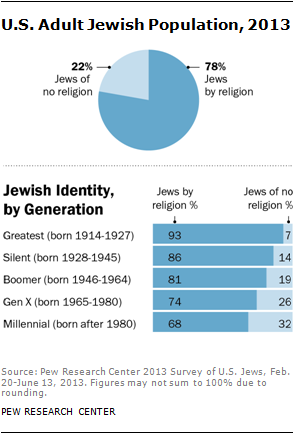
The percentage of U.S. adults who say they are Jewish when asked about their religion has declined by about half since the late 1950s and currently is a little less than 2%. Meanwhile, the number of Americans with direct Jewish ancestry or upbringing who consider themselves Jewish, yet describe themselves as atheist, agnostic or having no particular religion, appears to be rising and is now about 0.5% of the U.S. adult population.1
The changing nature of Jewish identity stands out sharply when the survey’s results are analyzed by generation. Fully 93% of Jews in the aging Greatest Generation identify as Jewish on the basis of religion (called “Jews by religion” in this report); just 7% describe themselves as having no religion (“Jews of no religion”). By contrast, among Jews in the youngest generation of U.S. adults – the Millennials – 68% identify as Jews by religion, while 32% describe themselves as having no religion and identify as Jewish on the basis of ancestry, ethnicity or culture.
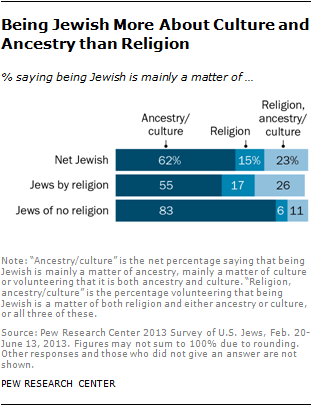
This shift in Jewish self-identification reflects broader changes in the U.S. public. Americans as a whole – not just Jews – increasingly eschew any religious affiliation. Indeed, the share of U.S. Jews who say they have no religion (22%) is similar to the share of religious “nones” in the general public (20%), and religious disaffiliation is as common among all U.S. adults ages 18-29 as among Jewish Millennials (32% of each).2
Secularism has a long tradition in Jewish life in America, and most U.S. Jews seem to recognize this: 62% say being Jewish is mainly a matter of ancestry and culture, while just 15% say it is mainly a matter of religion. Even among Jews by religion, more than half (55%) say being Jewish is mainly a matter of ancestry and culture, and two-thirds say it is not necessary to believe in God to be Jewish.
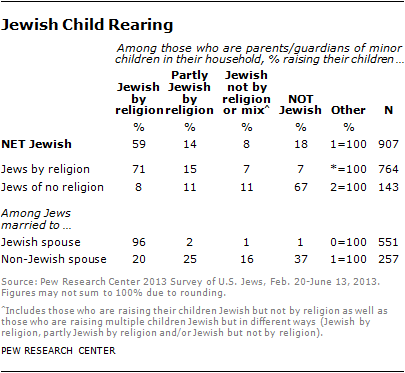
Compared with Jews by religion, however, Jews of no religion (also commonly called secular or cultural Jews) are not only less religious but also much less connected to Jewish organizations and much less likely to be raising their children Jewish. More than 90% of Jews by religion who are currently raising minor children in their home say they are raising those children Jewish or partially Jewish. In stark contrast, the survey finds that two-thirds of Jews of no religion say they are not raising their children Jewish or partially Jewish – either by religion or aside from religion.
Intermarriage is a related phenomenon. It is much more common among secular Jews in the survey than among Jews by religion: 79% of married Jews of no religion have a spouse who is not Jewish, compared with 36% among Jews by religion. And intermarried Jews, like Jews of no religion, are much less likely to be raising their children in the Jewish faith. Nearly all Jews who have a Jewish spouse say they are raising their children as Jewish by religion (96%). Among Jews with a non-Jewish spouse, however, 20% say they are raising their children Jewish by religion, and 25% are raising their children partly Jewish by religion. Roughly one-third (37%) of intermarried Jews who are raising children say they are not raising those children Jewish at all.
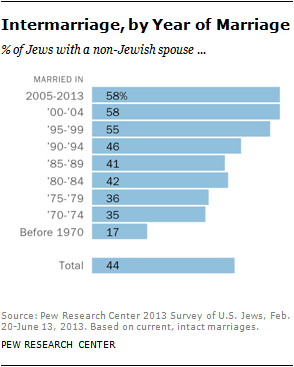
Moreover, intermarriage rates seem to have risen substantially over the last five decades. Among Jewish respondents who have gotten married since 2000, nearly six-in-ten have a non-Jewish spouse. Among those who got married in the 1980s, roughly four-in-ten have a non-Jewish spouse. And among Jews who got married before 1970, just 17% have a non-Jewish spouse.3
It is not clear whether being intermarried tends to make U.S. Jews less religious, or being less religious tends to make U.S. Jews more inclined to intermarry, or some of both. Whatever the causal connection, the survey finds a strong association between secular Jews and religious intermarriage. In some ways, the association seems to be circular or reinforcing, especially when child rearing is added into the picture. Married Jews of no religion are much more likely than married Jews by religion to have non-Jewish spouses. Jews who have non-Jewish spouses are much less likely than those married to fellow Jews to be raising children as Jewish by religion and much more likely to be raising children as partially Jewish, Jewish but not by religion, or not Jewish at all. Furthermore, Jews who are the offspring of intermarriages appear, themselves, to be more likely to intermarry than Jews with two Jewish parents.
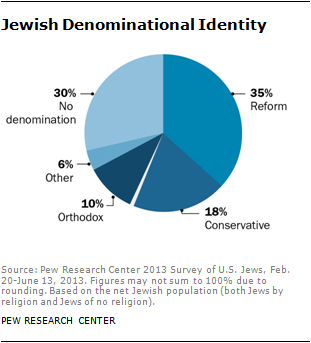
The survey also shows that Reform Judaism continues to be the largest Jewish denominational movement in the United States. One-third (35%) of all U.S. Jews identify with the Reform movement, while 18% identify with Conservative Judaism, 10% with Orthodox Judaism and 6% with a variety of smaller groups, such as the Reconstructionist and Jewish Renewal movements. About three-in-ten American Jews (including 19% of Jews by religion and two-thirds of Jews of no religion) say they do not identify with any particular Jewish denomination.
Though Orthodox Jews constitute the smallest of the three major denominational movements, they are much younger, on average, and tend to have much larger families than the overall Jewish population. This suggests that their share of the Jewish population will grow. In the past, high fertility in the U.S. Orthodox community has been at least partially offset by a low retention rate: Roughly half of the survey respondents who were raised as Orthodox Jews say they are no longer Orthodox. But the falloff from Orthodoxy appears to be declining and is significantly lower among 18-to-29-year-olds (17%) than among older people. (See discussion and table in Chapter 3, Jewish Identity.)
Within all three denominational movements, most of the switching is in the direction of less-traditional Judaism. The survey finds that approximately one-quarter of people who were raised Orthodox have since become Conservative or Reform Jews, while 30% of those raised Conservative have become Reform Jews, and 28% of those raised Reform have left the ranks of Jews by religion entirely. Much less switching is reported in the opposite direction. For example, just 7% of Jews raised in the Reform movement have become Conservative or Orthodox, and just 4% of those raised in Conservative Judaism have become Orthodox.
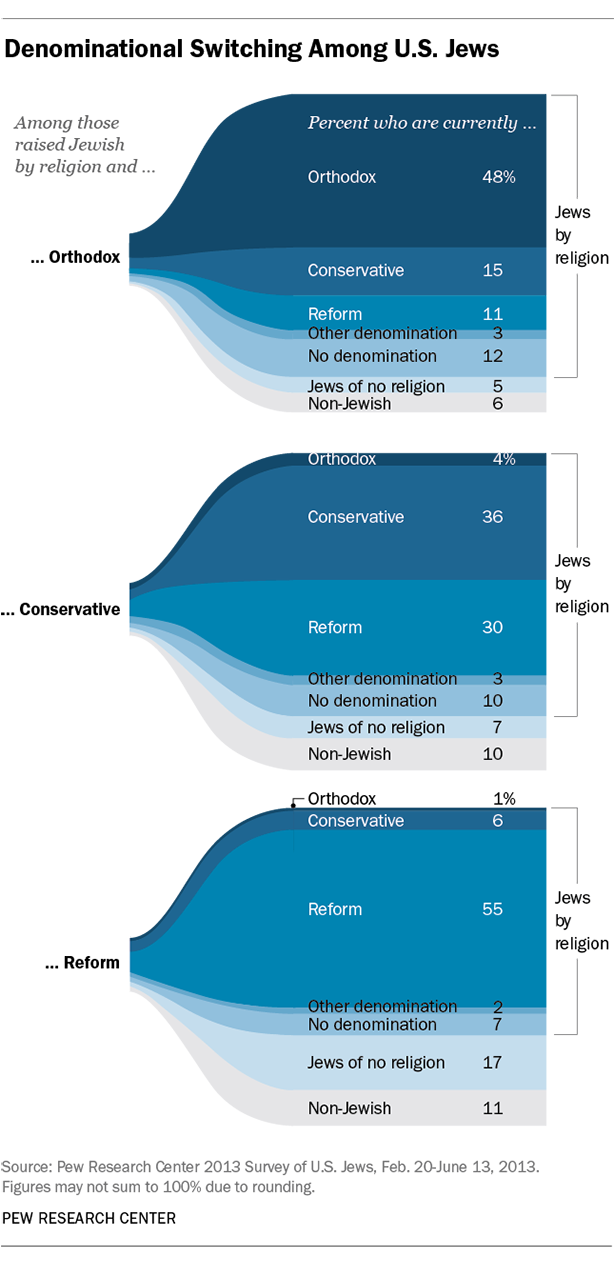
These are among the key findings of the Pew Research Center’s survey of U.S. Jews, conducted on landlines and cellphones among 3,475 Jews across the country from Feb. 20-June 13, 2013, with a statistical margin of error for the full Jewish sample of plus or minus 3.0 percentage points.
The new survey also finds that seven-in-ten Jews (70%) say they participated in a Passover meal (Seder) in the past year, and 53% say they fasted for all or part of Yom Kippur in 2012. These measures of observance appear to have ticked downward slightly compared with a national telephone survey conducted more than a decade ago, the 2000-2001 National Jewish Population Survey.4 In that poll, 78% of Jews said they had participated in a Seder in the past year, and 60% said they had fasted on Yom Kippur. If there has been any decline on these measures, however, it appears to be attributable to the rising number of Jews of no religion; rates of Passover and Yom Kippur observance have remained stable among Jews by religion.
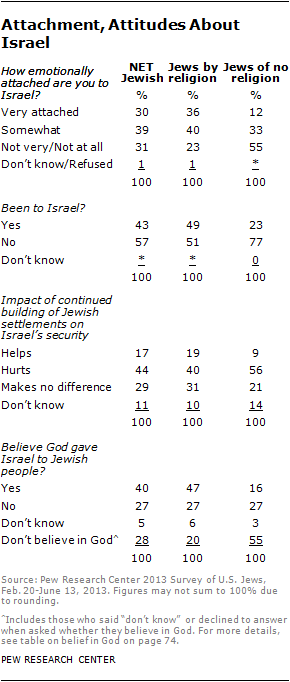
Despite the changes in Jewish identity in America, 94% of U.S. Jews (including 97% of Jews by religion and 83% of Jews of no religion) say they are proud to be Jewish. Three-quarters of U.S. Jews (including 85% of Jews by religion and 42% of Jews of no religion) also say they have “a strong sense of belonging to the Jewish people.” And emotional attachment to Israel has not waned discernibly among American Jews in the past decade, though it is markedly stronger among Jews by religion (and older Jews in general) than among Jews of no religion (and younger Jews in general).5
Overall, about seven-in-ten Jews surveyed say they feel either very attached (30%) or somewhat attached (39%) to Israel, essentially unchanged since 2000-2001. In addition, 43% of Jews have been to Israel, including 23% who have visited more than once. And 40% of Jews say they believe the land that is now Israel was given by God to the Jewish people.
At the same time, many American Jews express reservations about Israel’s approach to the peace process. Just 38% say the Israeli government is making a sincere effort to establish peace with the Palestinians. (Fewer still – 12% – think Palestinian leaders are sincerely seeking peace with Israel.) And just 17% of American Jews think the continued building of settlements in the West Bank is helpful to Israel’s security; 44% say that settlement construction hurts Israel’s own security interests.
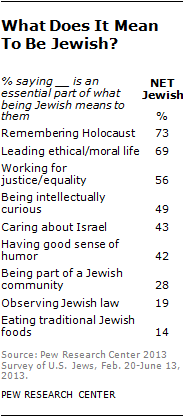
A key aim of the Pew Research Center survey is to explore Jewish identity: What does being Jewish mean in America today? Large majorities of U.S. Jews say that remembering the Holocaust (73%) and leading an ethical life (69%) are essential to their sense of Jewishness. More than half (56%) say that working for justice and equality is essential to what being Jewish means to them. And about four-in-ten say that caring about Israel (43%) and having a good sense of humor (42%) are essential to their Jewish identity.
But observing religious law is not as central to most American Jews. Just 19% of the Jewish adults surveyed say observing Jewish law (halakha) is essential to what being Jewish means to them. And in a separate but related question, most Jews say a person can be Jewish even if that person works on the Sabbath or does not believe in God. Believing in Jesus, however, is enough to place one beyond the pale: 60% of U.S. Jews say a person cannot be Jewish if he or she believes Jesus was the messiah.
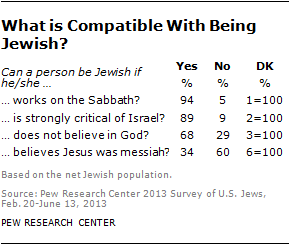
By several conventional measures, Jews tend to be less religious than the U.S. public as a whole. Compared with the overall population, for example, Jews are less likely to say that they attend religious services weekly or that they believe in God with absolute certainty. And just 26% of U.S. Jews say religion is very important in their lives, compared with 56% of the general public. (Orthodox Jews are a clear exception in this regard, exhibiting levels of religious commitment that place them among the most religiously committed groups in the country.) But while relatively few Jews attach high importance to religion, far more (46%) say being Jewish is very important to them.
Other findings from the Pew Research Center survey include:
- Jews from the former Soviet Union and their offspring account for roughly one-tenth of the U.S. Jewish population; 5% of Jewish adults say they were born in the former Soviet Union, and an additional 6% say they were born in the U.S. but have at least one parent who was born in the former Soviet Union.
- Jews have high levels of educational attainment. Most Jews are college graduates (58%), including 28% who say they have earned a post-graduate degree. By comparison, 29% of U.S. adults say they graduated from college, including 10% who have a post-graduate degree.
- Fully one-quarter of Jews (25%) say they have a household income exceeding $150,000, compared with 8% of adults in the public as a whole. At the same time, 20% of U.S. Jews report household incomes of less than $30,000 per year; about six-in-ten Jews in this low-income category are either under age 30 or 65 or older.
- Roughly four-in-ten U.S. Jewish adults (39%) say they live in a household where at least one person is a member of a synagogue. This includes 31% of Jewish adults (39% of Jews by religion and 4% of Jews of no religion) who say they personally belong to a synagogue, temple or other congregation.
- Jews think several other minority groups face more discrimination than they do. Roughly seven-in-ten Jews (72%) say gays and lesbians face a lot of discrimination in American society, and an equal number say there is lot of discrimination against Muslims. More than six-in-ten (64%) say blacks face a lot of discrimination. By comparison, 43% say Jews face a lot of discrimination. Overall, 15% of Jews say that in the past year they personally have been called offensive names or snubbed in a social setting because they are Jewish.
- Half of Jews (52%), including 60% of Jews by religion and 24% of Jews of no religion, say they know the Hebrew alphabet. But far fewer (13% of Jews overall, including 16% of Jews by religion and 4% of Jews of no religion) say they understand most or all of the words when they read Hebrew.
- Jews are heavily concentrated in certain geographic regions: 43% live in the Northeast, compared with 18% of the public as a whole. Roughly a quarter of Jews reside in the South (23%) and in the West (23%), while 11% live in the Midwest. Half of Jews (49%) reside in urban areas and a similar number (47%) reside in the suburbs; just 4% of Jews reside in rural areas.
- As a whole, Jews support the Democratic Party over the Republican Party by more than three-to-one: 70% say they are Democrats or lean toward the Democratic Party, while 22% are Republicans or lean Republican. Among Orthodox Jews, however, the balance tilts in the other direction: 57% are Republican or lean Republican, and 36% are Democrats or lean Democratic.
About the Survey
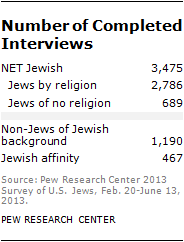
These are some of the findings of the new Pew Research Center survey, conducted Feb. 20-June 13, 2013, among a nationally representative sample of U.S. Jews. This is the most comprehensive national survey of the Jewish population since the 2000-2001 National Jewish Population Survey. More than 70,000 screening interviews were conducted to identify Jewish respondents in all 50 states and the District of Columbia. Longer interviews were completed with 3,475 Jews, including 2,786 Jews by religion and 689 Jews of no religion.
Interviews were conducted in English and Russian by random digit dialing on both landlines and cellphones. In order to reach Jewish respondents most efficiently, the survey focused on telephone exchanges for counties where previous surveys indicate that at least some Jews reside. Overall, the survey covered geographic areas that are home to more than 90% of U.S. adults. Counties were excluded from the survey only if (a) no Jews had been interviewed in those counties in more than 150 Pew Research Center surveys conducted over the past decade and (b) no other surveys in a Brandeis University database had ever interviewed a Jew in those counties and (c) no synagogues or institutions of Jewish education were known to be located in those counties at the time of the Pew Research survey.6 Based on this geographic coverage, more than 95% of the Jewish population, including 99% of the Jewish by religion population, is estimated to have been eligible to be called for the survey. A more detailed explanation of the survey’s methodology is provided in Appendix A (PDF).
In addition to interviewing Jews, the survey interviewed 1,190 people of Jewish background – U.S. adults who were raised Jewish or had at least one Jewish parent, but who now have a religion other than Judaism (most are Christian) or who say they do not consider themselves Jewish (either by religion or aside from religion). Finally, the survey also interviewed 467 people with a Jewish affinity – people who have a religion other than Judaism (or have no religion) and who were not raised Jewish and did not have a Jewish parent, but who nevertheless consider themselves Jewish or partially Jewish in some way.
This report focuses primarily on Jews by religion and Jews of no religion, which are combined into a “net” Jewish category. The size and characteristics of people of Jewish background and Jewish affinity are summarized in Chapter 1 (Population Estimates) and Chapter 7 (People of Jewish Background and Jewish Affinity).
Acknowledgments
The Pew Research Center’s 2013 survey of U.S. Jews was conducted by the center’s Religion & Public Life Project with generous funding from The Pew Charitable Trusts and the Neubauer Family Foundation.
Many Pew Research Center staff members contributed to this effort. Alan Cooperman oversaw the research project and served as lead editor of the report. Gregory Smith took the lead in the development of the survey instrument and sampling plan as well as the analysis of the results. Conrad Hackett and Noble Kuriakose developed the population estimates.
The report’s overview was written by Cooperman and Smith. Chapters 1 and 2 were written by Hackett, Smith, Cooperman and Kuriakose. Chapter 3 was written by Smith and Fatima Ghani. Besheer Mohamed and Juliana Horowitz wrote Chapters 4 and 5. Elizabeth Sciupac wrote Chapters 6 and 7. Smith, Hackett and Mohamed drafted Appendix A (Methodology). The report was number checked by Phillip Connor, Kathleen Flynn, Cary Funk, Jessica Martinez, Michael Robbins and Neha Sahgal as well as Ghani, Hackett, Kuriakose, Mohamed, Sciupac and Smith.
Others at the Pew Research Center who provided editorial or research guidance include Alan Murray, Andrew Kohut, Paul Taylor, Scott Keeter, Jon Cohen and Jeffrey Passel. Leah Christian, formerly a Pew Research Center senior researcher, also contributed to the project. Other staff members who contributed include Sandra Stencel, Erin O’Connell, Michael Lipka, Joseph Liu, Tracy Miller, Adam Nekola, Liga Plaveniece, Carla Ritz, Stacy Rosenberg, Bethany Smith, Bill Webster and Diana Yoo.
Fieldwork for the survey was carried out by the firm Abt SRBI, with Benjamin Phillips as project manager and Stas Kolenikov as lead statistician. Abt SRBI’s Mark Schulman, Chintan Turakhia and Charles DiSogra reviewed the weighting of the survey.
The Pew Research Center received invaluable advice on the survey questionnaire, methodology and analysis of results from a panel of advisers that included several of the leading figures in the study of American Jewry: Rabbi B. Elka Abrahamson, President of The Wexner Foundation, New Albany, Ohio; Sarah Bunin Benor, Associate Professor of Contemporary Jewish Studies, Hebrew Union College-Jewish Institute of Religion, Los Angeles; Steven M. Cohen, Research Professor of Jewish Social Policy at Hebrew Union College-Jewish Institute of Religion and Director of the Berman Jewish Policy Archive at NYU Wagner; Sergio DellaPergola, Shlomo Argov Professor Emeritus of Israel-Diaspora Relations at The Hebrew University of Jerusalem; David Dutwin, Executive Vice President and Chief Methodologist, Social Science Research Solutions, Media, Pa.; Jane Eisner, Editor-in-Chief, The Jewish Daily Forward, New York City; Laurence Kotler-Berkowitz, Senior Director of Research and Analysis and Director of the Berman Jewish DataBank at The Jewish Federations of North America, New York City; Jonathan Sarna, Joseph H. & Belle R. Braun Professor of American Jewish History at Brandeis University, Waltham, Mass.; Leonard Saxe, Klutznick Professor of Contemporary Jewish Studies and Social Policy at Brandeis University and Director of the university’s Cohen Center for Modern Jewish Studies and the Steinhardt Social Research Institute; Jack Wertheimer, Joseph and Martha Mendelson Professor of American Jewish History at The Jewish Theological Seminary, New York City; and Leon Wieseltier, Literary Editor of The New Republic, Washington, D.C.
In addition, the Pew Research Center’s Religion & Public Life Project would like to thank several other institutions and individuals who generously provided data and advice: Elizabeth Tighe, Matthew Boxer and Charles Kadushin at the Steinhardt Social Research Institute at Brandeis University; Samuel Heilman, Distinguished Professor of Sociology and Harold Proshansky Chair in Jewish Studies at Queens College, CUNY; Bruce A. Phillips, Professor of Jewish Communal Service in the Louchheim School of Judaic Studies at Hebrew Union College-Jewish Institute of Religion and the University of Southern California, Los Angeles; and John C. Green, Director of the Ray C. Bliss Institute of Applied Politics and Distinguished Professor of Political Science at the University of Akron, Ohio.
Roadmap to the Report
The rest of this report details the survey’s findings on the size, beliefs, practices and attitudes of the U.S. Jewish population. The first section estimates the size of the American Jewish population using various definitions of who is a Jew. The second section covers intermarriage and demographic characteristics, such as age, education and income. The third section examines aspects of Jewish identity, including questions about what is essential to Jewish identity, what is incompatible with being Jewish, friendship networks, Jewish education and child rearing. The fourth section explores religious beliefs and practices, including attendance at religious services, lighting Sabbath candles and participating in the Passover meal. The fifth section looks at attitudes toward and connection with Israel, including views on a two-state solution and the Israeli-Palestinian peace process. The sixth section discusses political views and social attitudes, including political party identification, views of President Obama, attitudes toward homosexuality and perceptions of discrimination. The seventh section describes the characteristics of people of Jewish background and Jewish affinity, including their answers to an open-ended question about the ways in which they consider themselves Jewish. The survey methodology, topline and full questionnaire are included in appendices.
The online version of the report includes two interactive features – one illustrating Jewish denominational switching and the other allowing the user to calculate the size of the Jewish population based on his or her own definition of who is a Jew.




